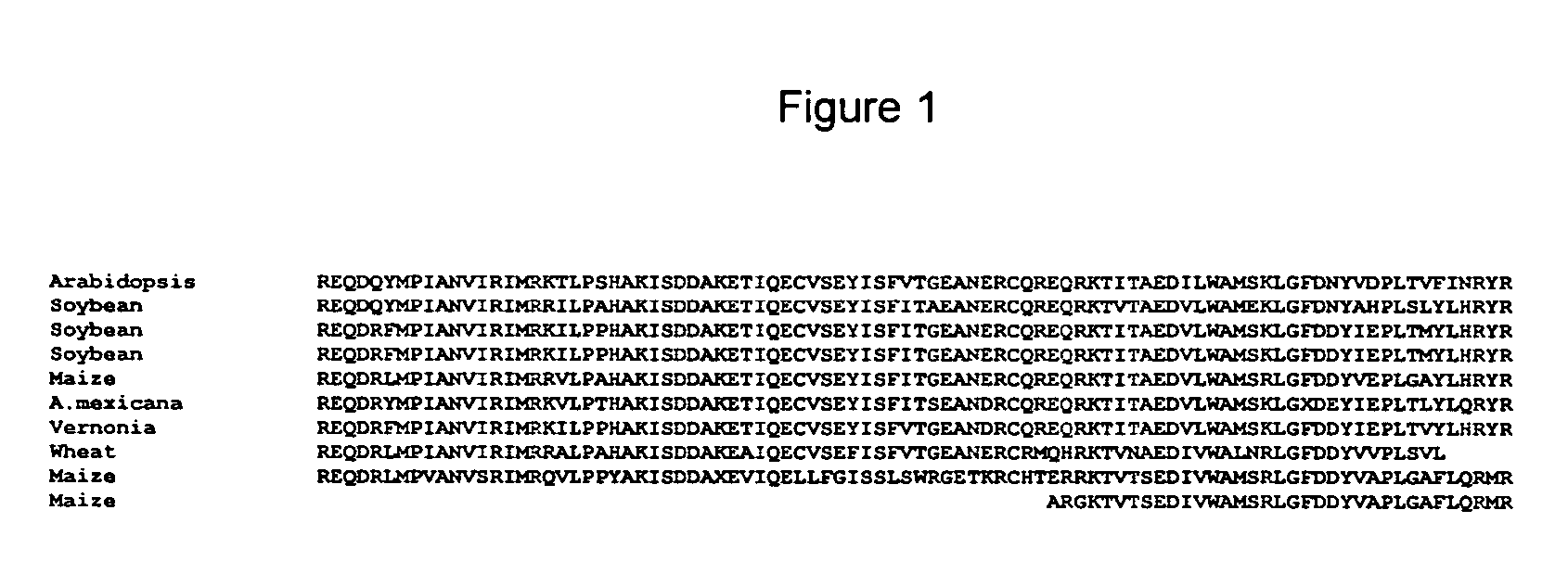Transcriptional activator nucleic acids, polypeptides and methods of use thereof
a transcriptional activator and nucleic acid technology, applied in the field of plant molecular biology, can solve the problems of difficult and time-consuming transformation of agronomically important maize inbred lines, inability to produce favorable culture responses of hybrids, and serious genotype limitations, so as to reduce the problem of gene silencing, reduce the expression of polynucleotides encoding the proteins of the present invention, and produce efficient hybrid seeds.
- Summary
- Abstract
- Description
- Claims
- Application Information
AI Technical Summary
Benefits of technology
Problems solved by technology
Method used
Image
Examples
example 1
Library Construction Used for the Maize LEC1 EST's
[0175] A. Total RNA Isolation
[0176] Total RNA was isolated from maize embryo and regenerating callus tissues with TRIzol Reagent (Life Technology Inc. Gaithersburg, Md.) using a modification of the guanidine isothiocyanate / acid-phenol procedure described by Chomczynski and Sacchi (Chomczynski, P., and Sacchi, N. Anal. Biochem. 162, 156 (1987)). In brief, plant tissue samples were pulverized in liquid nitrogen before the addition of the TRIzol Reagent, and then were further homogenized with a mortar and pestle. Addition of chloroform followed by centrifugation was conducted for separation of an aqueous phase and an organic phase. The total RNA was recovered by precipitation with isopropyl alcohol from the aqueous phase.
[0177] B. Poly(A)+ RNA Isolation The selection of poly(A)+RNA from total RNA was performed using PolyATact system (Promega Corporation. Madison, Wis). In brief, biotinylated oligo(dT) primers were used to hybridize t...
example 2
Sequencing and cDNA Subtraction Procedures Used for Maize LEC1 EST's
[0180] A. Sequencing Template Preparation
[0181] Individual colonies were picked and DNA was prepared either by PCR with M13 forward primers and M13 reverse primers, or by plasmid isolation. All the cDNA clones were sequenced using M13 reverse primers.
[0182] B. Q-bot Subtraction Procedure
[0183] cDNA libraries subjected to the subtraction procedure were plated out on 22×22 cm2 agar plate at density of about 3,000 colonies per plate. The plates were incubated in a 37° C. incubator for 12-24 hours. Colonies were picked into 384-well plates by a robot colony picker, Q-bot (GENETIX Limited). These plates were incubated overnight at 37° C.
[0184] Once sufficient colonies were picked, they were pinned onto 22×22 cm2 nylon membranes using Q-bot. Each membrane contained 9,216 colonies or 36,864 colonies. These membranes were placed onto agar plate with appropriate antibiotic. The plates were incubated at 37° C. for overni...
example 3
[0192] Identification of Maize LEC1 EST's from a Computer Homology Search Gene identities were determined by conducting BLAST (Basic Local Alignment Search Tool; Altschul, S. F., et al., (1993) J. Mol. Biol. 215:403-410; see also www.ncbi.nlm.nih.gov / BLAST / ) searches under default parameters for similarity to sequences contained in the BLAST “nr” database (comprising all non-redundant GenBank CDS translations, sequences derived from the 3-dimensional structure Brookhaven Protein Data Bank, the last major release of the SWISS-PROT protein sequence database, EMBL, and DDBJ databases). The cDNA sequences were analyzed for similarity to all publicly available DNA sequences contained in the “nr” database using the BLASTN algorithm. The DNA sequences were translated in all reading frames and compared for similarity to all publicly available protein sequences contained in the “nr” database using the BLASTX algorithm (Gish, W. and States, D. J. (1993) Nature Genetics 3:266-272) provided by ...
PUM
| Property | Measurement | Unit |
|---|---|---|
| temperature | aaaaa | aaaaa |
| temperature | aaaaa | aaaaa |
| pH | aaaaa | aaaaa |
Abstract
Description
Claims
Application Information
 Login to View More
Login to View More - R&D
- Intellectual Property
- Life Sciences
- Materials
- Tech Scout
- Unparalleled Data Quality
- Higher Quality Content
- 60% Fewer Hallucinations
Browse by: Latest US Patents, China's latest patents, Technical Efficacy Thesaurus, Application Domain, Technology Topic, Popular Technical Reports.
© 2025 PatSnap. All rights reserved.Legal|Privacy policy|Modern Slavery Act Transparency Statement|Sitemap|About US| Contact US: help@patsnap.com

